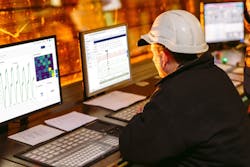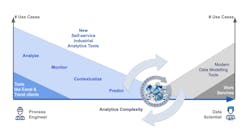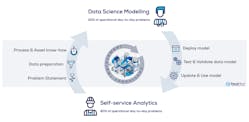Most industrial manufacturing organizations have two groups at opposite ends of the problem-solving spectrum: the process experts who are production savvy and usually have analytics know-how but limited time to do the analysis, and the data scientists who are analytics savvy with a strong mathematics background and usually do not have production know-how.
When an abnormal production situation occurs, the process experts will try to solve it themselves. If they are unable to, they will consult the data scientists. However, since plants typically have many sites, the central data science team needs to support and answer questions from all the sites, which could potentially become a critical bottleneck in the analytics chain.
Two possible routes could happen: the requests pile up at the central data science group, resulting in a long wait for feedback, or requests are abandoned, leaving the process experts in a status-quo situation with no answers to their problems.
A solution to this problem-solving dilemma would be to grow the analytics capabilities — to grow the analytics maturity — of the process experts with a self-service analytics tool that empowers this group to do more of the data analysis. This way, they would become analytics self-sufficient to answer the production questions on their own without having to ask for support/help from the central analytics troubleshooting group, except for the most complex issues.
The process experts would then be able to solve 80% of the day-to-day questions themselves, leveraging their process knowledge. This approach frees up the data scientists to optimally use their skill sets to focus on the remaining 20% of highly complicated issues. This problem-solving approach is a win-win combination of both groups' knowledge and experience.
Over the years, however, the analytics-enabled process experts have shown an increased interest in going beyond this level of analytics maturity. They wanted to gain more analytics knowledge and more flexibility in terms of analysis capabilities. In doing so, they further closed the gap with data scientists, becoming "citizen data scientists" — people whose jobs are outside the field of analytics but who can do advanced diagnostic, predictive and prescriptive analytics.
Team optimization with embedded notebooks
The first self-service analytics software enabled operational experts in the process manufacturing industries to analyze, monitor and predict operational performance using sensor-generated time-series data. The goal of this software was to empower engineers with analytics for improving operational excellence, without the need of data scientists. Basically, this software brought data science to the process experts.
The new and more advanced version of self-service analytics software goes to the next level of the industrial analytics progression by providing an embedded notebook. With these new capabilities, users have more flexibility, allowing them to have a more advanced analytics experience. Process experts can prepare all operational data themselves with the advanced trend analysis capabilities of a self-service analytics tool and then load the data views into the notebook. With their data science libraries of choice, they can create and run the scripts themselves. The results can be made available for the entire organization in the form of new (predictive) tags and related monitors, or the notebook visualizations can be shown as dashboard tiles.
With the embedded notebooks, process experts can become more analytics mature, getting closer to the level of the analytics expertise of data scientists. And the potential of use-cases increases greatly because this notebook technology gives its users the flexibility to play around with various algorithms and dive into the data in ways they could not before. For example:
- Extend process visualization with extra visuals for dashboarding and reporting purposes such as heatmaps, treemaps or joint plots.
- Perform statistical analysis to compare sets of good and bad production data (t-test/ANOVA).
- Do low-pass filtering or exponential smoothing to remove seasonal effects from data.
- Create a nonlinear predictive model to predict quality (using neural networks).
- Do advanced mass balance calculations using the self-service analytics search results.
However, even with their increased analytics maturity, process experts are usually not as knowledgeable about mathematics/statistics/AI/ML/modeling theory as data scientists. And that is OK because that is exactly where the boundary is between data science knowledge and process knowledge.
Process experts think in terms of their production process and trends in the data: Is there an anomaly in the data or is a part of the production stagnating and why? Data scientists think in terms of data cleaning, models and algorithms. They are typically not self-service analytics users but can potentially become users especially with the new notebooks.
With this new capability embedded into self-service analytics software, data scientists will be able to easily work with process experts on joint projects since they can directly continue their work in the same tool where the process experts prepared the data beforehand. As a result, the embedded notebooks allow for a collaborative, cohesive and interactive team of process experts and data scientists that can more effectively solve process problems. Subsequently, the data scientists will have more free time to support projects for the process experts if complex use-cases arise.
Case study: How a chemical processor achieved global collaboration with a self-service analytics tool
As one of the world’s leading specialty chemical companies, Clariant Corporation produces care chemicals, natural resources, catalysis and energy, and plastics and coatings. Three years ago, the company started using a self-service analytics tool in Germany before rolling out the software to its North American and China sites. And, Clariant is currently planning to extend the use of the software to its other sites around the world.
The self-service analytics software brought different people from different cultures and backgrounds together and allowed them to exchange crucial process ideas and general best practices to collaborate — and thus coordinate — global production. Additionally, the software allowed the process experts on different continents to compare production data and information across different sites. This information was shared on one screen for all the sites, thus eliminating data silos. Using the data from these sites, the process experts could work together to establish golden production batches for all the sites, which was not possible before the software.
The self-service analytics tool also helped the process experts and the data scientists to collaborate and optimally use their individual skill sets. According to Clariant data scientist Nimet Sterneberg, the self-service analytics tool enabled him to “gather the data, getting the right data in the right samples” for his data science.
The use of the software resulted in important benefits: decreasing the amount of raw materials needed and, more importantly, decreasing the waiting times — the cycle times of the batches, which resulted in a cost savings for Clariant. And, because the process experts could directly see the advantages of the tool, they were easily motivated to adopt and use it.
Invest in analytics capacity to secure a competitive edge and future
With the new set of functionalities of self-service analytics software, capabilities are expanded for process and asset experts to continue their analytics maturity journey toward solving 80% of the operational day-to-day problems. Conversely, it potentially opens up self-service analytics tools for data scientists by providing the full flexibility of a notebook environment, embedded in the software with one-click access to prepared contextualized data.
To solve the 20% of the more serious or more complex problems, both problem-solving groups are needed. The analytics maturity of the asset engineers and operators needs to grow, and the process knowledge of these essential personnel needs to be brought to the data scientists, which the embedded notebooks can do. What results is a greatly improved collaboration between both groups, resulting in greater success for the entire organization.
“Classical data science depends on bringing process/asset know-how to the data scientist, while self-service analytics aims at packaging up a subset of the data science modeling capabilities and bringing these to the subject matter expert as a robust set of features,” said TrendMiner CTO Thomas Dhollander. “Companies that recognize the potential in interweaving these complementary approaches will be the ones that can accelerate their operational efficiency and competitive advantage.”
These two problem-solving groups are complementary. The new self-service analytics notebook features are designed to target and optimize each group’s skill set, closing the gap between the process experts and data scientists. By investing in this type of problem-solving approach, organizations can win with analytics, thus securing their competitive edge and their future in industrial manufacturing.
Nick Van Damme is the director of products at TrendMiner and is responsible for translating the vision of TrendMiner into the product roadmap. He is passionate about using advanced analytics, big data and manufacturing intelligence to support digital transformation, Industry 4.0 and internet of things (IoT) initiatives.
TrendMiner




